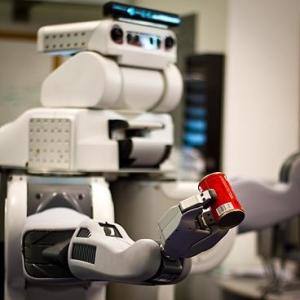Honing Household Helpers: Computer Scientists Work Toward Improving Robots’ Ability to Plan and Perform Complex Actions, Domestically and Elsewhere
Imagine a robot able to retrieve a pile of laundry from the back of a cluttered closet, deliver it to a washing machine, start the cycle and then zip off to the kitchen to start preparing dinner.
This may have been a domestic dream a half-century ago, when the fields of robotics and artificial intelligence first captured public imagination. However, it quickly became clear that even “simple” human actions are extremely difficult to replicate in robots. Now, MIT computer scientists are tackling the problem with a hierarchical, progressive algorithm that has the potential to greatly reduce the computational cost associated with performing complex actions.
Leslie Kaelbling, the Panasonic Professor of Computer Science and Engineering, and Tomás Lozano-Pérez, the School of Engineering Professor of Teaching Excellence and co-director of MIT’s Center for Robotics, outline their approach in a paper titled “Hierarchical Task and Motion Planning in the Now,” which they presented at the IEEE Conference on Robotics and Automation earlier this month in Shanghai.
Traditionally, programs that get robots to function autonomously have been split into two types: task planning and geometric motion planning. A task planner can decide that it needs to traverse the living room, but be unable to figure out a path around furniture and other obstacles. A geometric planner can figure out how to get to the phone, but not actually decide that a phone call needs to be made.
Of course, any robot that’s going to be useful around the house must have a way to integrate these two types of planning. Kaelbling and Lozano-Pérez believe that the key is to break the computationally burdensome larger goal into smaller steps, then make a detailed plan for only the first few, leaving the exact mechanisms of subsequent steps for later. “We’re introducing a hierarchy and being aggressive about breaking things up into manageable chunks,” Lozano-Pérez says. Though the idea of a hierarchy is not new, the researchers are applying an incremental breakdown to create a timeline for their “in the now” approach, in which robots follow the age-old wisdom of “one step at a time.”
The result is robots that are able to respond to environments that change over time due to external factors as well as their own actions. These robots “do the execution interleaved with the planning,” Kaelbling says.
The trick is figuring out exactly which decisions need to be made in advance, and which can — and should — be put off until later.









